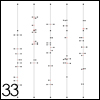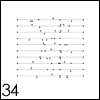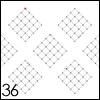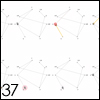Study no. 32.1
Performance Instructions
For 8 strings and/or winds
There are a few ways to perform this piece, but several elements that are consistent regardless of the approach. Each player is assigned one notational aggregate (indidcated by one of the 8 "star-shaped" groupings of lines and note names), and should follow that aggregate throughout (with one exception that will be detailed below).
Variation 1: When the attack cursor (the circle moving around each aggregate) reaches a note name, play that pitch in some octave (octave displacements may be permissable depending on the collective opinion of the ensemble). This may be short or sustained, and the playing technique can be varied.
Variation 2: If possible, after a note is played, sustain that note, and gliss to the next pitch in time with the movement of the cursor, arriving at the new pitch as the cursor arrives.
Variation 3: Combine these two approaches in some way (this is likely preferred).
At times a small circle will appear on the outside of the attack cursor and begin moving counterclockwise. This means that note will be repeated/sustained until the orbiting circle reaches 12 o'clock.
The center node should be assigned an auxiliary sound. This sound can be any sound produced by each player's respective instrument, but should be percussive and quite banal.
At times a line will emerge that connects 2 or more attack cursors from different aggregates. When this happens, you have the option to follow the attack cursor that the line is connected to, but only as long as it is visible. After it disappears, you must return to your own aggregate.
Dynamics should be fairly consistent throughout, although modifications here and there may be quite lovely.
Ryan Ross Smith, 2014
If you would like a copy of this animated score for performance, or have any questions about the animated notation used in this piece, feel free to get in touch! My contact information can be found here.




